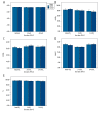Analgesia and respiratory function after laparoscopic cholecystectomy in patients receiving ultrasound-guided bilateral oblique subcostal transversus abdominis plane block: a randomized double-blind study
- PMID: 25948166
- PMCID: PMC4434982
- DOI: 10.12659/MSM.893593
Analgesia and respiratory function after laparoscopic cholecystectomy in patients receiving ultrasound-guided bilateral oblique subcostal transversus abdominis plane block: a randomized double-blind study
Abstract
Background: Transversus abdominis plane (TAP) block has been shown to ameliorate postoperative pain after abdominal surgery. Postoperative pain-associated respiratory compromise has been the subject of several studies. Herein, we evaluate the effect of oblique subcostal TAP (OSTAP) block on postoperative pain and respiratory functions during the first 24 postoperative hours.
Material/methods: In this double-blind, randomized study, 76 patients undergoing laparoscopic cholecystectomy were assigned to either the OSTAP group (n=38) or control group (n=38). Bilateral ultrasound-guided OSTAP blocks were performed with 20 ml 0.25% bupivacaine after induction of general anesthesia. Both the OSTAP and control groups were treated with paracetamol, tenoxicam, and tramadol as required for postoperative analgesia. Visual Analog Scale (VAS) pain scores (while moving and at rest), forced expiratory volume in the first second (FEV1), forced vital capacity (FVC), peak expiratory flow rate (PEFR), arterial blood gas variables, and opioid consumption were assessed during first 24 h.
Results: VAS pain scores at rest and while moving were significantly lower in the OSTAP group on arrival to PACU and at 2 h postoperatively. The total postoperative tramadol requirement was significantly reduced at 0-2 h and 2-24 h in the OSTAP group. Postoperative deterioration in FEV1 and FVC was significantly less in the OSTAP group when compared to the control group (P<0.01 and P<0.05, respectively). There were no between-group differences in arterial blood gas variables.
Conclusions: After laparoscopic cholecystectomy, OSTAP block can provide significant improvement in respiratory function and better pain relief with lower opioid requirement.
Figures





Similar articles
-
Transversus abdominis plane block as a component of multimodal analgesia for laparoscopic cholecystectomy.J Clin Anesth. 2016 Nov;34:72-8. doi: 10.1016/j.jclinane.2016.03.033. Epub 2016 May 2. J Clin Anesth. 2016. PMID: 27687350 Clinical Trial.
-
The analgesic efficacy of oblique subcostal transversus abdominis plane block after laparoscopic hysterectomy: A randomized, controlled, observer-blinded study.Medicine (Baltimore). 2019 Jan;98(1):e13994. doi: 10.1097/MD.0000000000013994. Medicine (Baltimore). 2019. PMID: 30608444 Free PMC article. Clinical Trial.
-
Ultrasound-guided erector spinae plane block versus oblique subcostal transversus abdominis plane block for postoperative analgesia of adult patients undergoing laparoscopic cholecystectomy: Randomized, controlled trial.J Clin Anesth. 2019 Nov;57:31-36. doi: 10.1016/j.jclinane.2019.03.012. Epub 2019 Mar 6. J Clin Anesth. 2019. PMID: 30851501 Clinical Trial.
-
Analgesic effect of erector spinae plane block in adults undergoing laparoscopic cholecystectomy: a systematic review and meta-analysis of randomized controlled trials.BMC Anesthesiol. 2023 Jan 6;23(1):7. doi: 10.1186/s12871-023-01969-6. BMC Anesthesiol. 2023. PMID: 36609244 Free PMC article.
-
Dexamethasone added to local anesthetics in ultrasound-guided transversus abdominis plain (TAP) block for analgesia after abdominal surgery: A systematic review and meta-analysis of randomized controlled trials.PLoS One. 2019 Jan 8;14(1):e0209646. doi: 10.1371/journal.pone.0209646. eCollection 2019. PLoS One. 2019. PMID: 30620730 Free PMC article.
Cited by
-
Comparison of transversus abdominis plane block and quadratus lumborum block for post-caesarean section analgesia: A randomised clinical trial.Indian J Anaesth. 2019 Oct;63(10):820-826. doi: 10.4103/ija.IJA_61_19. Epub 2019 Oct 10. Indian J Anaesth. 2019. PMID: 31649394 Free PMC article.
-
Advances in regional anaesthesia: A review of current practice, newer techniques and outcomes.Indian J Anaesth. 2018 Feb;62(2):94-102. doi: 10.4103/ija.IJA_433_17. Indian J Anaesth. 2018. PMID: 29491513 Free PMC article. Review.
-
Analgesic efficacy of ultrasound guided transversus abdominis plane block versus local anesthetic infiltration in adult patients undergoing single incision laparoscopic cholecystectomy: A randomized controlled trial.Anesth Essays Res. 2016 Sep-Dec;10(3):561-567. doi: 10.4103/0259-1162.186620. Anesth Essays Res. 2016. PMID: 27746552 Free PMC article.
-
Continuous Transversus Abdominis Plane Blocks via Laparoscopically Placed Catheters for Bariatric Surgery.Obes Surg. 2017 Oct;27(10):2575-2582. doi: 10.1007/s11695-017-2667-9. Obes Surg. 2017. PMID: 28389846 Clinical Trial.
-
Efficacy of OSTAP, ESP block, trocar site local anesthetic injection in elective laparoscopic cholecystectomy: A randomized controlled trial.Medicine (Baltimore). 2025 Aug 1;104(31):e43607. doi: 10.1097/MD.0000000000043607. Medicine (Baltimore). 2025. PMID: 40760576 Free PMC article. Clinical Trial.
References
-
- Slinger P. From the Journal archives: Postoperative analgesia: effect on lung volumes. Can J Anaesth. 2014;61(2):200–2. - PubMed
-
- Ali J, Weisel RD, Layug AB, et al. Consequences of postoperative alterations in respiratory mechanics. Am J Surg. 1974;128(3):376–82. - PubMed
-
- Brull R, McCartney CJ, Chan VW, et al. Neurological complications after regional anesthesia: contemporary estimates of risk. Anesth Analg. 2007;104(4):965–74. - PubMed
-
- Rigg JR, Jamrozik K, Myles PS, et al. Epidural anaesthesia and analgesia and outcome of major surgery: a randomised trial. Lancet. 2002;359(9314):1276–82. - PubMed
-
- Staehr-Rye AK, Rasmussen LS, Rosenberg J, et al. Minimal impairment in pulmonary function following laparoscopic surgery. Acta Anaesthesiol Scand. 2014;58(2):198–205. - PubMed
Publication types
MeSH terms
Substances
LinkOut - more resources
Full Text Sources
Medical
Miscellaneous

